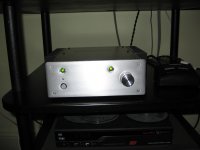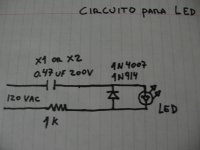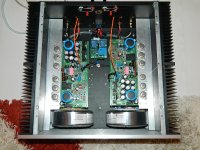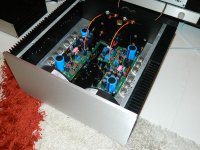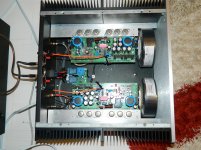Pics are the topic.
Technical discussion should be moved to an appropriate Thread.
Safety MUST be highlighted in this Thread. We cannot have beginners killing themselves because they copied some stupid detail shown on DIY audio.
Pin .
I am deadly serious.
If I was not barred by the Forum Rules I would be much less polite to Members who show little to no regard for user safety.
That chassis as shown is potentially dangerous. There is no argument to support the techniques shown in the pic. Any Member who tries to support that type of bad practice after it has been highlighted is a fool.
Technical discussion should be moved to an appropriate Thread.
Safety MUST be highlighted in this Thread. We cannot have beginners killing themselves because they copied some stupid detail shown on DIY audio.
Pin .
I am deadly serious.
If I was not barred by the Forum Rules I would be much less polite to Members who show little to no regard for user safety.
That chassis as shown is potentially dangerous. There is no argument to support the techniques shown in the pic. Any Member who tries to support that type of bad practice after it has been highlighted is a fool.
Andrew, I'm not arguing with you on the safety hazard side because you're 1000% right, and yes it should be highlighted. We surely don't want anybody or their guests dying doing DIY... 
All I was saying is that people put in considerable amount of time building something that they're really proud of. Reason they post it here in the end.
It is just a question of wording that can hurt someones feeling. Sure feeling is better hurt than dying of shock hazard...
What I'm trying to say is highlight the positive side of someones build and then politely enforce the security measures, putting it mandatory for safety in the end but not making him/her feel like they're jackasses doing it this way. Some people just don't know, they're here to learn and we can teach them the right way. Just saying "man this is unprofessional" type sentence can and will hurt someones feeling and self esteem, especially publicly.
Anyways, like I have said you are correct to highlight those safety rules. And you were probably trying to protect the user and others making the same mistake.
My message was never intended to bring you down, ever
Have a good weekend!
Do
All I was saying is that people put in considerable amount of time building something that they're really proud of. Reason they post it here in the end.
It is just a question of wording that can hurt someones feeling. Sure feeling is better hurt than dying of shock hazard...
What I'm trying to say is highlight the positive side of someones build and then politely enforce the security measures, putting it mandatory for safety in the end but not making him/her feel like they're jackasses doing it this way. Some people just don't know, they're here to learn and we can teach them the right way. Just saying "man this is unprofessional" type sentence can and will hurt someones feeling and self esteem, especially publicly.
Anyways, like I have said you are correct to highlight those safety rules. And you were probably trying to protect the user and others making the same mistake.
My message was never intended to bring you down, ever
Have a good weekend!
Do
Much ado about nothing. When I look at the pictures I see the only wires carrying a dangerous voltage have extra sleeving fitted, and given that the wiring looms will not be subject to constant movement I can't see the problem. I am more concerned about location of the gate stopper resistor for the mosfet closest to the front panel.
Steve.
Steve.
Hi
I can not beleive the comments about my amplifier, I am actually a fully qualified electrical engineer. To say that this chasiss is electrical unsafe is wrong.
1st of all the 230v cabling is double insulated above the chassis and below, The unit is fully PAT tested and the Earth fault loop impedance is checked as well (Yes thats correct I have part P cert as well)
secondly the the main 230v connector is a correct Neutrik connector not a speaker connector as it may look like one from a distance.
All the fuse holders and mains relays are insulated and the correctly insulated with the correct type of Crimps used, with double insulated cable used.
I will accept all feedback but to say is unsafe is wrong, I have had a look around this site for other builds that I would say are very unsafe! I have seen at least ten builds that have exposed mains voltage terminals every where in the enclosure, thats why I try to increase my standards so others can follow. Perhaps other people can show their builds so we can all learn instead of being constant armchair critics who build nothing and bring nothing to this forum.
I accept the feedback about the holes but they are countersunk both ends, and where the mains voltage goes through the chassis it is again sleeved with heat shrink tubing. If certain people think this is unsafe, then you clearly have no knowledge in electrical engineering and should stick to civil engineering. I have been apprentice trained since the age of 16 (now 47) am have worked for Ford Motor Company and Procter & Gamble for all this years as a senior engineer ... so please I know when something is not safe. For example how many people check the Earth loop imedance and prospective earth fault current! well I do ... enough said before I loose it.
Nick James
I can not beleive the comments about my amplifier, I am actually a fully qualified electrical engineer. To say that this chasiss is electrical unsafe is wrong.
1st of all the 230v cabling is double insulated above the chassis and below, The unit is fully PAT tested and the Earth fault loop impedance is checked as well (Yes thats correct I have part P cert as well)
secondly the the main 230v connector is a correct Neutrik connector not a speaker connector as it may look like one from a distance.
All the fuse holders and mains relays are insulated and the correctly insulated with the correct type of Crimps used, with double insulated cable used.
I will accept all feedback but to say is unsafe is wrong, I have had a look around this site for other builds that I would say are very unsafe! I have seen at least ten builds that have exposed mains voltage terminals every where in the enclosure, thats why I try to increase my standards so others can follow. Perhaps other people can show their builds so we can all learn instead of being constant armchair critics who build nothing and bring nothing to this forum.
I accept the feedback about the holes but they are countersunk both ends, and where the mains voltage goes through the chassis it is again sleeved with heat shrink tubing. If certain people think this is unsafe, then you clearly have no knowledge in electrical engineering and should stick to civil engineering. I have been apprentice trained since the age of 16 (now 47) am have worked for Ford Motor Company and Procter & Gamble for all this years as a senior engineer ... so please I know when something is not safe. For example how many people check the Earth loop imedance and prospective earth fault current! well I do ... enough said before I loose it.
Nick James
Last edited:
Hi
I can not beleive the comments about my amplifier, I am actually a fully qualified electrical engineer. To say that this chasiss is electrical unsafe is wrong.
1st of all the 230v cabling is double insulated above the chassis and below, The unit is fully PAT tested and the Earth fault loop impedance is checked as well (Yes thats correct I have part P cert as well)
secondly the the main 230v connector is a correct Neutrik connector not a speaker connector as it may look like one from a distance.
All the fuse holders and mains relays are insulated and the correctly insulated with the correct type of Crimps used, with double insulated cable used.
I will accept all feedback but to say is unsafe is wrong, I have had a look around this site for other builds that I would say are very unsafe! I have seen at least ten builds that have exposed mains voltage terminals every where in the enclosure, thats why I try to increase my standards so others can follow. Perhaps other people can show their builds so we can all learn instead of being constant armchair critics who build nothing and bring nothing to this forum.
I accept the feedback about the holes but they are countersunk both ends, and where the mains voltage goes through the chassis it is again sleeved with heat shrink tubing. If certain people think this is unsafe, then you clearly have no knowledge in electrical engineering and should stick to civil engineering. I have been apprentice trained since the age of 16 (now 47) am have worked for Ford Motor Company and Procter & Gamble for all this years as a senior engineer ... so please I know when something is not safe. For example how many people check the Earth loop imedance and prospective earth fault current! well I do ... enough said before I loose it.
Nick James
Hi,
I've just been looking at your construction photos in detail. It's just possible that there has been a misunderstanding regarding your cable routing. The fact that you've used brown and blue insulated wire to carry mains voltages, DC supply rails and speaker output connections has led some to believe that the visible wires passing through the unprotected chassis holes are mains wires.
If you were to confirm that no mains voltage wiring passes through any chassis holes (without suitable grommets installed), then the concerns might change from that of a safety issue to that of a reliability issue. It appears to me that all of your mains wiring is confined to the upper side of the internal chassis plate and is well insulated.
feedback
Mr James, main thing is that you like them.
Those BK amp modules look rather, mm, let's say "interesting" from various angles.
(e.g. the fuses inbetween the transformer and power diodes, and 1 MOSFET output pair on a single pair of >50V rails)
Considered making your own (altered design) amp boards ?
currentflow, there is nothing wrong with nicks build from either safety or reliability aspects. The wires carrying mains voltage through openings are sleeved and no wiring will be subject to movement. I see far worse in my day job (Industrial and Commercial electronics and automation).This is DIY not aerospace.
Regards,
Steve.
Regards,
Steve.
currentflow, there is nothing wrong with nicks build from either safety or reliability aspects. The wires carrying mains voltage through openings are sleeved and no wiring will be subject to movement. I see far worse in my day job (Industrial and Commercial electronics and automation).This is DIY not aerospace.
Regards,
Steve.
srh, I wasn't criticising Nick's build. On the contrary, I was attempting to defend his construction method based on the concerns of others. Of course, in practice, the wiring should be stable and, from what can be determined from the photos, there should be no problem.
That said, I also believe that safety should be of paramount importance where mains is concerned and shouldn't be of less importance to DIY as it is with the "aerospace" industry, if only to comply with Murphy's Law.
Hi
I know who they are because I have looked at their profile .. but trust me they are on this site ....
regards
Nick
Yeah, I know that. I don't know where their DIY electronics buildings
 are located. Could anyone point me a link in this forum? Thanks.
are located. Could anyone point me a link in this forum? Thanks.here is one of civil amps... (for safety reason it is in overall view
An externally hosted image should be here but it was not working when we last tested it.
Last edited:
Nick - They're rather industrial looking if I do say so myself!Hi All
Just a quick question, what do you all think of the feet that I have made? the only reason I ask is that I have another member who said the chrome feet where ugly !! I disagree as they look really classy when you see them for real.
regards
Nick
- Home
- Amplifiers
- Solid State
- Post your Solid State pics here
